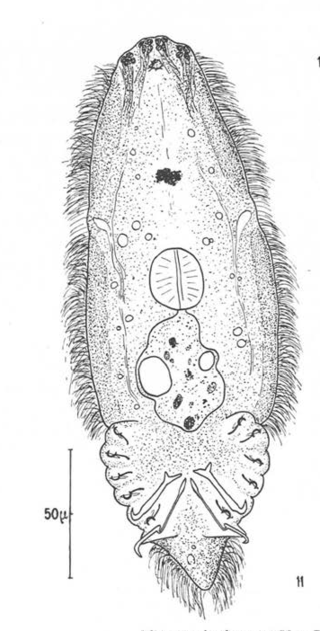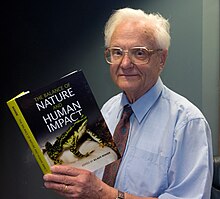
Platyhelminthes is a phylum of relatively simple bilaterian, unsegmented, soft-bodied invertebrates commonly called flatworms or flat worms. Being acoelomates, and having no specialised circulatory and respiratory organs, they are restricted to having flattened shapes that allow oxygen and nutrients to pass through their bodies by diffusion. The digestive cavity has only one opening for both ingestion and egestion ; as a result, the food can not be processed continuously.

Monogeneans, members of the class Monogenea, are a group of ectoparasitic flatworms commonly found on the skin, gills, or fins of fish. They have a direct lifecycle and do not require an intermediate host. Adults are hermaphrodites, meaning they have both male and female reproductive structures.

The Aspidogastrea is a small group of flukes comprising about 80 species. It is a subclass of the trematoda, and sister group to the Digenea. Species range in length from approximately one millimeter to several centimeters. They are parasites of freshwater and marine molluscs and vertebrates. Maturation may occur in the mollusc or vertebrate host. None of the species has any economic importance, but the group is of very great interest to biologists because it has several characters which appear to be archaic.
Rapoport's rule is an ecogeographical rule that states that latitudinal ranges of plants and animals are generally smaller at lower latitudes than at higher latitudes.

Species richness, or biodiversity, increases from the poles to the tropics for a wide variety of terrestrial and marine organisms, often referred to as the latitudinal diversity gradient. The latitudinal diversity gradient is one of the most widely recognized patterns in ecology. It has been observed to varying degrees in Earth's past. A parallel trend has been found with elevation, though this is less well-studied.
Thorson's rule is an ecogeographical rule which states that benthic marine invertebrates at low latitudes tend to produce large numbers of eggs developing to pelagic and widely dispersing larvae, whereas at high latitudes such organisms tend to produce fewer and larger lecithotrophic (yolk-feeding) eggs and larger offspring, often by viviparity or ovoviviparity, which are often brooded.
The hypothesis of effective evolutionary time attempts to explain gradients, in particular latitudinal gradients, in species diversity. It was originally named "time hypothesis".
A vacant niche or empty niche is an ecological niche in a particular ecosystem that is not occupied by a particular species. The issue of what exactly defines a vacant niche and whether they exist in ecosystems is controversial. The subject is intimately tied into a much broader debate on whether ecosystems can reach equilibrium, where they could theoretically become maximally saturated with species. Given that saturation is a measure of the number of species per resource axis per ecosystem, the question becomes: is it useful to define unused resource clusters as niche 'vacancies'?
The term phylogenetic niche conservatism has seen increasing use in recent years in the scientific literature, though the exact definition has been a matter of some contention. Fundamentally, phylogenetic niche conservatism refers to the tendency of species to retain their ancestral traits. When defined as such, phylogenetic niche conservatism is therefore nearly synonymous with phylogenetic signal. The point of contention is whether or not "conservatism" refers simply to the tendency of species to resemble their ancestors, or implies that "closely related species are more similar than expected based on phylogenetic relationships". If the latter interpretation is employed, then phylogenetic niche conservatism can be seen as an extreme case of phylogenetic signal, and implies that the processes which prevent divergence are in operation in the lineage under consideration. Despite efforts by Jonathan Losos to end this habit, however, the former interpretation appears to frequently motivate scientific research. In this case, phylogenetic niche conservatism might best be considered a form of phylogenetic signal reserved for traits with broad-scale ecological ramifications. Thus, phylogenetic niche conservatism is usually invoked with regards to closely related species occurring in similar environments.
Lethacotyle is a genus of polyopisthocotylean monogeneans, included in the family Protomicrocotylidae.
The genus includes only two species: Lethacotyle fijiensisManter & Price, 1953 , the type-species of the genus, and Lethacotyle veraJustine, Rahmouni, Gey, Schoelinck, & Hoberg, 2013 . Both species are parasitic on the gills of jacks in the Pacific Ocean. They are known only from three localities: off Fiji, Andaman Islands, and New Caledonia.
The genus Lethacotyle is special in that its members have no clamps on their posterior attachment organ or haptor, in contrast to most polyopisthocotylean Monogenean which have clamps. This is reflected in the etymology of the name, which, according to Manter & Price is "from letha = forgetting, and cotyle = cup, and refers to the absence of clamps".

The haptor is the attachment organ of the monogeneans, a group of parasitic Platyhelminthes. The haptor is sometimes called opisthaptor to emphasize that it is located in the posterior part of the body, and to differentiate it from the prohaptor, a structure including glands located at the anterior part of the body. According to Yamaguti (1963), the chief adhesive organ of the monogeneans, the haptor, is posterior, more or less discoid, muscular, may be divided into alveoli or loculi, is usually provided with anchors, has nearly always marginal larval hooklets, or is in a reduced form with anchors. The haptor may consist of symmetrical or asymmetrical, sessile or pedunculate, muscular suckers or clamps with or without supporting sclerites; accessory adhesive organs may be present in form of armed plaques, lappets or appendices.

Louis Euzet was a French parasitologist.
Hexabothriidae is a family of monogenean parasites. The family name was proposed by Emmett W. Price in 1942. The family includes 14-16 genera according to authors and about 60 species; all are parasitic on the gills of chondrichthyan fishes.

Neodermata is a clade of rhabditophoran flatworms containing the parasitic groups Trematoda, Monogenea and Cestoda.
Rhabditophora is a subphylum of flatworms. It includes all parasitic flatworms and most free-living species that were previously grouped in the now obsolete class Turbellaria. Therefore, it contains the majority of the species in the phylum Platyhelminthes, excluding only the catenulids, to which they appear to be the sister group.

Rhabdocoela is an order of flatworms in the class Rhabditophora with about 1700 species described worldwide. The order was first described in 1831 by Christian Gottfried Ehrenberg. Most of rhabdocoels are free-living organisms, but some live symbiotically with other animals.

Chimaericola leptogaster is a species of polyopisthocotylean monogenean in the family Chimaericolidae. It is ectoparasitic on the gills of the chimaera Chimaera monstrosa.
Delane C. Kritsky is an American parasitologist who specialised on the Monogenea, a class of parasitic flatworms which are important ectoparasites of fishes. His research was mainly in the fields of taxonomy, faunistics, and phylogeny of the Monogenea.

Jean-Lou Justine, French parasitologist and zoologist, is a professor at the National Museum of Natural History in Paris, France, and a specialist of fish parasites and invasive land planarians.

An oncomiracidium is the ciliated and free-living larva of a monogenean, a type of parasitic flatworm commonly found on fish. It is similar to the miracidium of Trematoda, but has sclerotised (hardened) hooklets not found in the latter.











